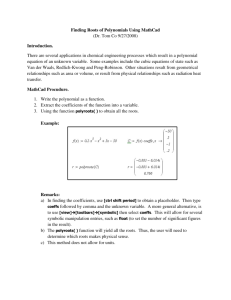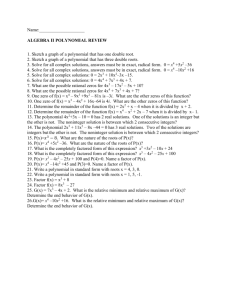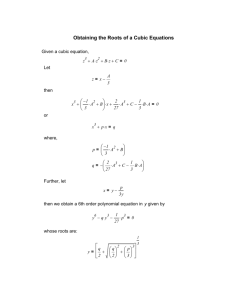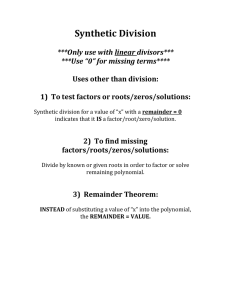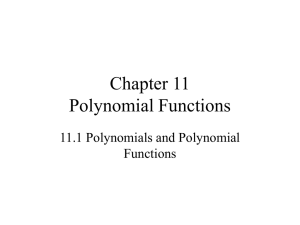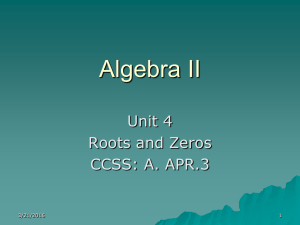Complex Zeros
advertisement
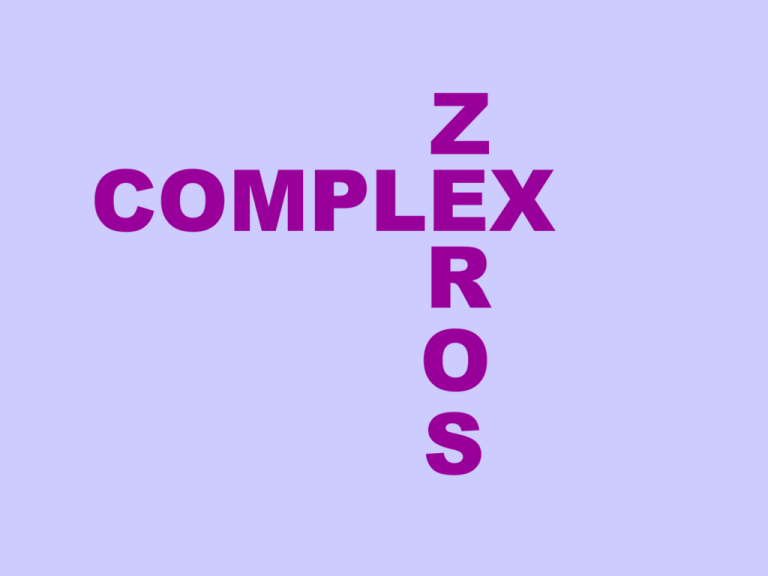
Z COMPLEX R O S Complex zeros or roots of a polynomial could result from one of two types of factors: x 40 2 Type 1 x 2i x2 2x 5 0 Type 2 x x 4 2 2 22 415 2 16 1 2i 21 2 Notice that with either type, the complex zeros come in conjugate pairs. There are 2 complex solutions that have the same real term and opposite signs on imaginary term. This will always be the case. Complex zeros come in conjugate pairs. So if asked to find a polynomial that has zeros, 2 and 1 – 3i, you would know another root would be 1 + 3i. Let’s find such a polynomial by putting the roots in factor form and multiplying them together. If x = the root then x - the root is the factor form. x 2x 1 3i x 1 3i x 2x 1 3i x 1 3i x 2 x 2 Multiply the last two factors together. All i terms should disappear when simplified. x 3xi x 1 3i 3xi 3i 9i x 2 x 2 x 10 2 2 -1 Now multiply the x – 2 through x 4 x 14 x 20 3 2 Here is a 3rd degree polynomial with roots 2, 1 - 3i and 1 + 3i Let’s take this polynomial and pretend we didn’t know the roots and work the other direction so we can see the relationship to everything we’ve learned here. f x x 4 x 14 x 20 3 Possible 2 1, 2, 4, 5, 10, 20 rational roots 1 By Descartes Rule there are 3 or 1 positive real zeros (3 sign changes in f(x)) and no negative real roots (no sign changes in f(-x)). Let’s try 2 2 1 (synthetic division) 1 -4 2 -2 14 -4 10 -20 20 0 x 2 x 10 0 2 By quad formula: x 1 3i Now put variables back in and factor or use quadratic formula So there was one positive and two imaginary roots Use the given root to find the remaining roots of the function f x 3x 5x 25x 45x 18; root 3i 4 3 2 Since 3i is a root we also know that its conjugate -3i is also a root. Let’s use synthetic division and reduce our polynomial by these roots then. 3i -3i 3 5 25 45 -18 9i -27+15i -45-6i 18 3 5+9i -2+15i -6i 0 -9i -15i 6i 0 So the roots3of this are 30i, -3i, 1/3, and -2 5 function -2 Put variables in here & set to 0 2 3x 5 x 2 0 and factor or formula this to get 3x 1 x 2 0 remaining roots. Acknowledgement I wish to thank Shawna Haider from Salt Lake Community College, Utah USA for her hard work in creating this PowerPoint. www.slcc.edu Shawna has kindly given permission for this resource to be downloaded from www.mathxtc.com and for it to be modified to suit the Western Australian Mathematics Curriculum. Stephen Corcoran Head of Mathematics St Stephen’s School – Carramar www.ststephens.wa.edu.au


